|
|
|
Aime & Norman
Lykes Residence (1959/66 - S.433) |
| |
|
INTRODUCTION
FLOOR PLAN 1968
STORRER 1970 KOPPES
1975 THOMPSON 2004 STEINER
2014 STEINER
FURNITURE
RELATED ITEMS |
| |
| |
|
|
Designed by Frank Lloyd Wright in 1959, it was to be his
last residential work. As John Rattenbury describes it,
"After studying the topographic map, Wright set it aside for
a while and worked on other projects. He always allowed an
idea to germinate before committing to it to paper. The next
morning he quickly sketched a plan on the map... With a
panoramic view in mind, and considering the shape of the
natural plateau, he drew two overlapping circles... After a
while, Wright got up from his desk and walked out of the
studio. He never returned. The next day he was in the
hospital with an intestinal problem..." A Living
Architecture, Rattenbury, 2000, p.247-250. Working drawings
were completed in 1966 by Taliesin Fellow, John Rattenbury,
who had worked closely with Mr. Wright on the initial plans.
Rattenbury also supervised the construction of the home.
The home is dramatically built into the
hillside, overlooking Phoenix and the valley. Based on
intersecting and overlapping |
|
circles, the home is over 2800 square feet. The circular
design is constructed of desert-rose tinted concrete blocks.
The interior is finished with Philippine mahogany.
A covered walkway leads from the circular
drive, around the exterior wall of the circular Garden
Court, to the entrance of the home. Two steps down leads
into the circular living room. From the Entry, five steps up
leads to the bedroom wing.
In 1993, John Rattenbury oversaw a remodel
for a new owner. The fourth bedroom was combined with the
Master bedroom, and two other bedrooms were combined to
create a larger guest room, reducing five to three. The
spiral staircase adjacent to the workspace that lead down to
a workshop under the Living Room was converted to a home
theater.
The first opportunity to view
this home was April 2004. Our second opportunity was ten
years later in April 2014.
|
| |
|
|
| |
|
|
| |
|
|
| |
| |
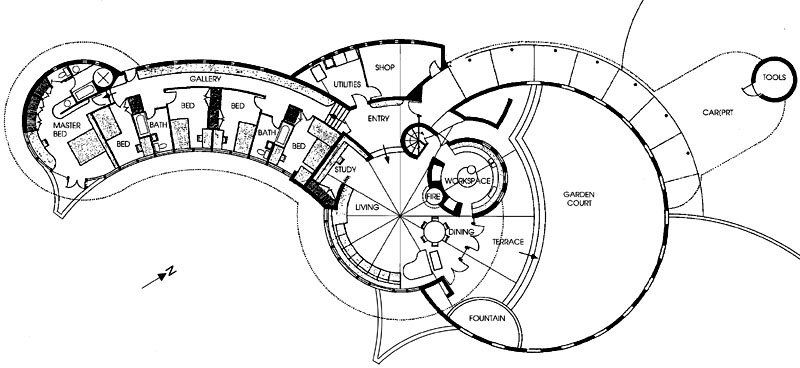 |
| Floor Plan
courtesy of William Storrer, adapted by Douglas M. Steiner. |
| |
| |
| |
| |
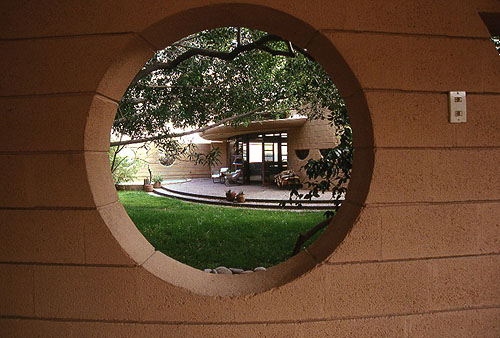 |
|
1) Lykes Residence Garden Court and Terrace viewed from the
North from the exterior side of the Garden Court wall. The
fountain is on the left, the Living Room is in the center,
the Workspace is on the right. The Terrace is in the
foreground. Photographed by William Storrer. Courtesy of the
Oak Park Public Library. |
| |
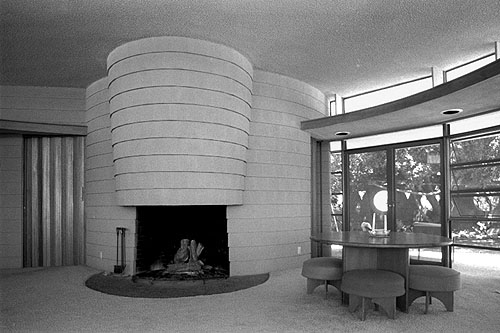 |
|
2) Lykes Residence Living Room viewed from the South. John
Rattenbury worked with Wright on the initial plans for the
home. According to Rattenbury, a few days before his death,
Wright sketched out the plans for the home, set them aside,
but never was able to returned to them, due to his death.
Rattenbury completed the working drawings and specifications
in 1966. Construction took place on the home for the next
two years. He designed the furniture and built-ins, adapted
from the original plans created by Wright before his death.
The bi-fold doors on the left leads to the workspace which
is located behind the fireplace. The doors on the right
leads to the Garden Court. The table and hassock/chairs are
on the right. Appears to be taken before curtains were
installed in the Living Room, visible in the 1970 image.
Photographed by William Storrer. Courtesy of the Oak Park
Public Library.
|
| |
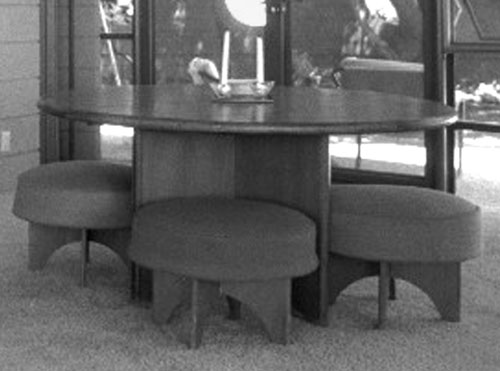 |
|
2A) Detail of the Lykes Residence Dining Room table and
chairs. According to John Rattenbury, a few days before his
death, Wright sketched out the plans for the home, set them
aside, but never was able to returned to them, due to his
death. Rattenbury completed the working drawings and
specifications in 1966. Construction took place on the home
for the next two years. Rattenbury designed the furniture
and built-ins, adapted from the original plans created by
Wright before his death. |
| |
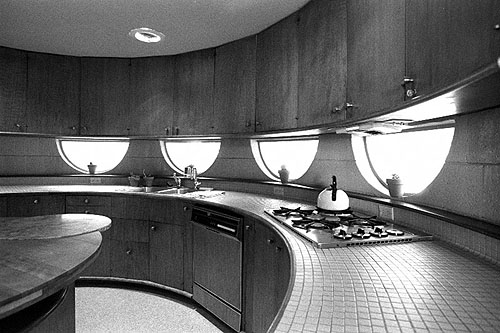 |
|
3) Lykes Residence Workspace. John Rattenbury worked with
Wright on the initial plans for the home. According to
Rattenbury, a few days before his death, Wright sketched out
the plans for the home, set them aside, but never was able
to returned to them, due to his death. Rattenbury completed
the working drawings and specifications in 1966.
Construction took place on the home for the next two years.
He designed the built-ins, adapted from the original plans
created by Wright before his death. Cabinets are constructed
of Philippine mahogany. Photographed by William Storrer.
Courtesy of the Oak Park Public Library. |
| |
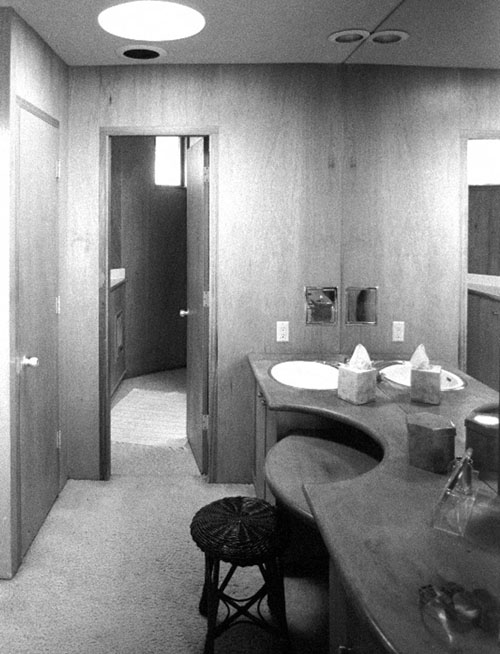 |
| 4) Lykes
Residence Master Bath. John Rattenbury worked with Wright on
the initial plans for the home. According to Rattenbury, a
few days before his death, Wright sketched out the plans for
the home, set them aside, but never was able to returned to
them, due to his death. Rattenbury completed the working
drawings and specifications in 1966. Construction took place
on the home for the next two years. He designed the
built-ins, adapted from the original plans created by Wright
before his death. Walls are covered with, and the cabinets
are constructed of, Philippine mahogany. Photographed by
William Storrer. Courtesy of the Oak Park Public Library. |
| |
| |
| |
| |
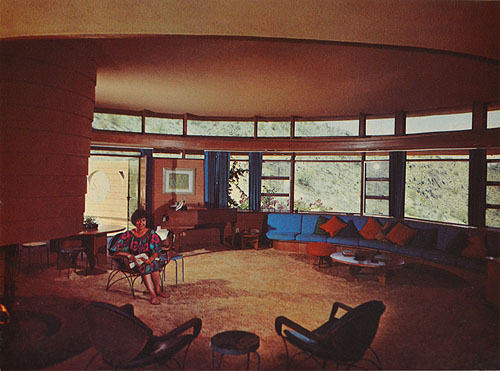 |
|
Lykes Residence Living Room viewed from the study. The
fireplace is on the far left. The exit to the Garden Court
is on the left behind Aime Lykes. Built-in seating under the
windows are on the right. John Rattenbury worked with Wright
on the initial plans for the home. According to Rattenbury,
a few days before his death, Wright sketched out the plans
for the home, set them aside, but never was able to returned
to them, due to his death. Rattenbury completed the working
drawings and specifications in 1966. He designed the
furniture and built-ins, adapted from the original plans
created by Wright before his death. The round Dining Room
table is on the left. A small round end table is in the
center. A hassock and coffee table is on the right.
Photographed by Neil Koppes. Published in "Phoenix", July
1970, p.55.
|
| |
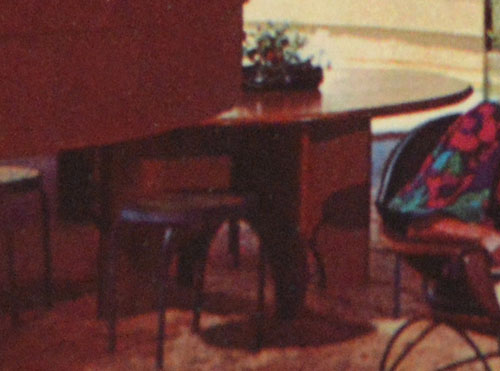 |
| Detail of
the round Lykes Residence Dining Room table. |
| |
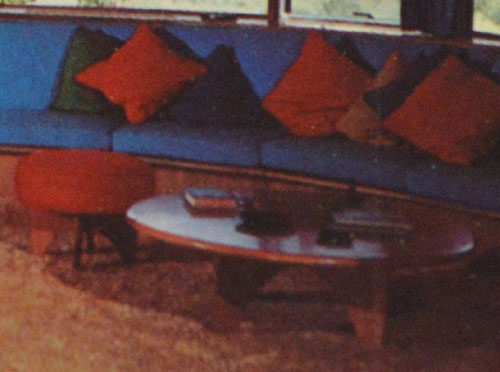 |
|
Detail of the Lykes Residence hassock and coffee table.
|
| |
| |
| |
| |
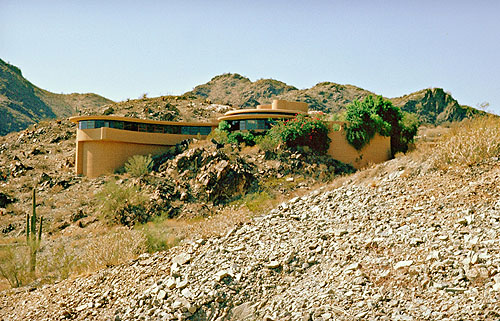 |
| Aime and
Norman Lykes Residence viewed from the Southeast, 1975. The
Bedroom wing is on the left. The Master Bedroom is on the
far left, four additional Bedrooms are between the Master
Bedroom and the Living Room. The Living Room is in the
center. Clerestory windows cast indirect lighting into the
Living Room. Frank Lloyd Wright formed the home around the
rock outcropping he wanted to preserve. The Garden Court on
the right. Courtesy of, and photographed in November 1973 by
Anthony Thompson. |
| |
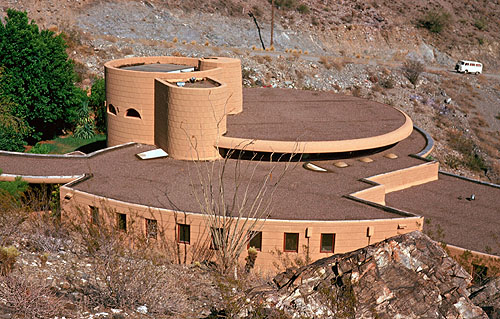 |
| Aime and
Norman Lykes Residence viewed from the West, 1975. The Shop
and Utilities rooms are in the foreground. The covered
walkway and Garden Court is on the left. The Workspace
(Kitchen) and Living Room is in the center. The Bedroom wing
is to the right. Courtesy of, and photographed in November
1973 by Anthony Thompson. |
| |
| |
| |
| |
|
|
| Set of ten
images of the exterior Lykes Residence photographed on April
26, 2004. Designed by Frank Lloyd Wright in 1959, it was to
be his last residential work. Working drawings were
completed in 1966 by Taliesin Fellow, John Rattenbury, who
had worked closely with Mr. Wright on the initial plans.
Rattenbury also supervised the construction of the home.
Based on intersecting |
|
and
overlapping circles, the home is over 2800 square feet. The
circular design is constructed of desert-rose tinted
concrete blocks. The home is dramatically built into the
hillside, overlooking Phoenix and the valley. As we approach
the home it is viewed from below and reached by a steep hill
on the East side of the property. |
| |
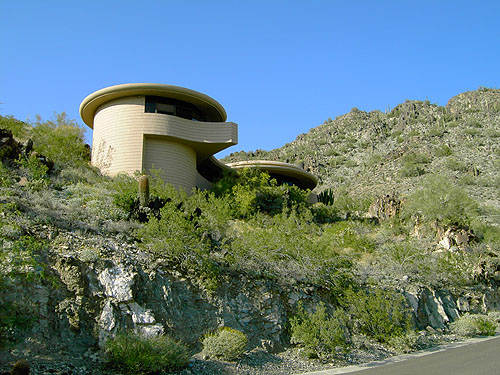 |
| 1) Lykes
Residence viewed from the South. The Bedroom wing can be
seen in the foreground on the left. The Master Bedroom
Balcony is cantilevered, formed by two intersecting circles.
Originally four additional Bedrooms were between the Master Bedroom and
the Living Room. In 1993, rooms were combined to reduce the
number of bedrooms from five to three. The Living Room is in the background on the
right. (ST#2004.69.0615-1) |
| |
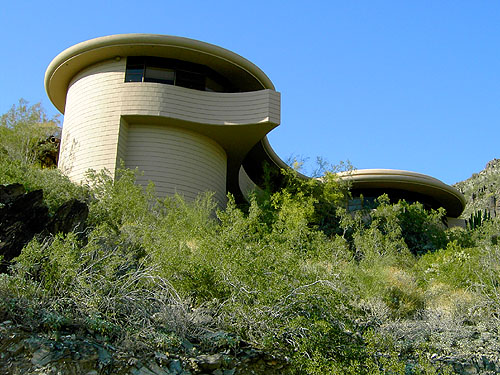 |
| 2) Lykes
Residence viewed from the South. The Bedroom wing can be
seen in the foreground on the left. The Master Bedroom
Balcony is cantilevered, formed by two intersecting circles.
Originally four additional Bedrooms were between the Master Bedroom and
the Living Room. The Living Room is in the background on the
right. (ST#2004.69.0615-2) |
| |
 |
| 2A) Detail
of the Master Bedroom. The Master Bedroom Balcony is
cantilevered, formed by two intersecting circles. Mortar in
the horizontal joints are racked, vertical joints are flush
with the face. (ST#2004.69.0615-2A) |
| |
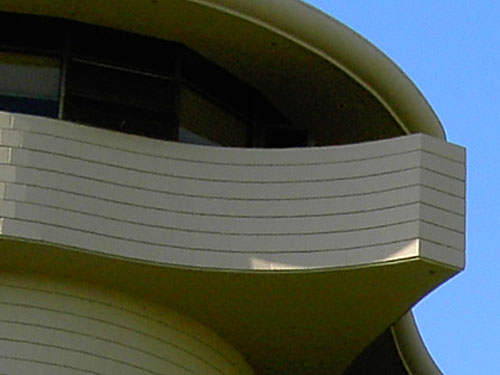 |
| 2B) Detail
of the Master Bedroom's cantilevered Balcony, formed by two
intersecting circles. (ST#2004.69.0615-2B) |
| |
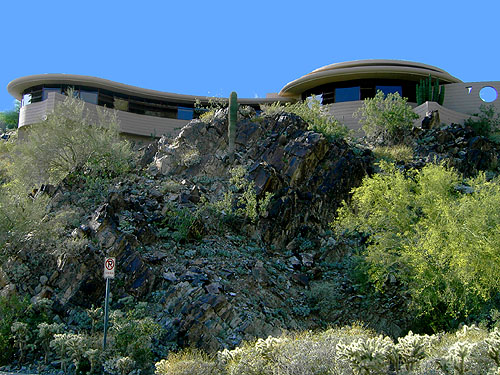 |
| 3) Lykes
Residence viewed from the Southeast. The Bedroom wing is on the left. The Master Bedroom is on the far left,
originally four
additional Bedrooms were between the Master Bedroom and the
Living Room. The Living Room is on the right.
Frank Lloyd Wright formed
the home around the rock outcropping he wanted to preserve. (ST#2004.69.0615-3) |
| |
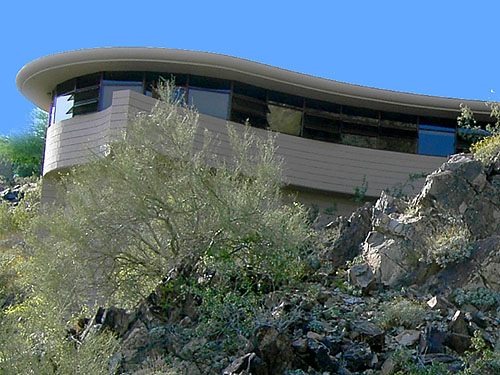 |
| 3A) Detail
of the Master Bedroom on the left. Originally four additional Bedrooms
were between the Master Bedroom and the Living Room. (ST#2004.69.0615-3A) |
| |
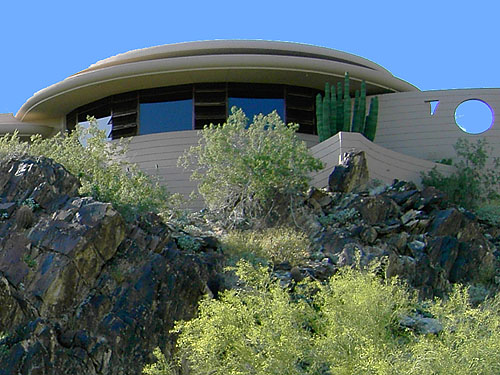 |
| 3B) Detail
of the Living Room. To the far right is the garden court and
swimming pool. The built-in planter to the right follows the
curvature of the bedroom wing. Like the Master Bedroom
balcony, it is formed by two intersecting circles. (ST#2004.69.0615-3B) |
| |
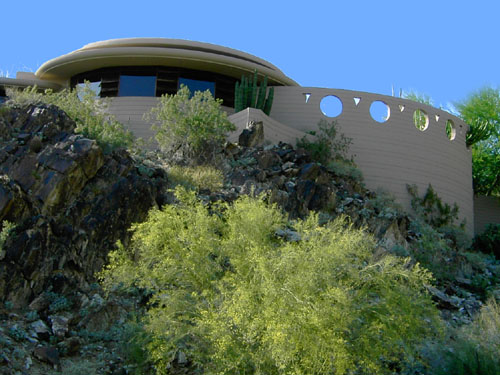 |
| 4) Lykes
Residence viewed from the Southeast. The Living Room is on
the left, Garden Court on the right. Clerestory windows cast
indirect lighting into the Living Room. (ST#2004.69.0615-4) |
| |
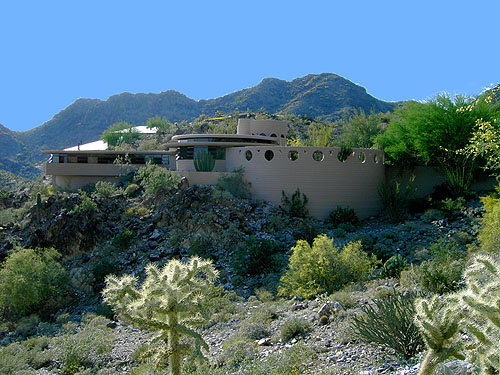 |
| 5) Lykes
Residence viewed from the Northeast. The Master Bedroom and
the Bedroom Wing is on the left. The Living Room is in the
center, the
Garden Court on the right. Clerestory windows cast
indirect lighting into the Living Room. (ST#2004.69.0615-5) |
| |
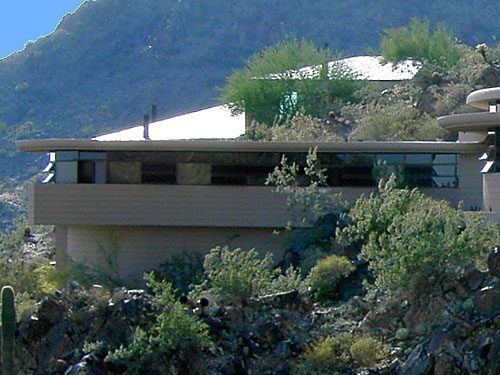 |
| 5A) Detail
of the Master Bedroom and the Bedroom Wing. (ST#2004.69.0615-5A) |
| |
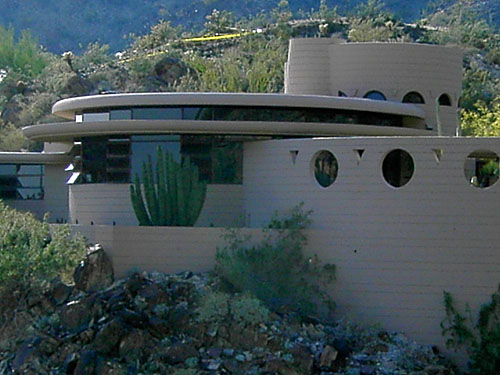 |
| 5B) Detail
of the Living Room. A built-in planter follows the curvature
of the bedroom wing. Clerestory windows cast indirect
lighting into the Living Room. The
Garden Court on the right. The circular Workspace (kitchen)
can be seen in the background. A circular staircase leads to
an office above the Workspace. Half circular windows pierce
the walls of the office. The built-in planter follows the
curvature of the bedroom wing. (ST#2004.69.0615-5B) |
| |
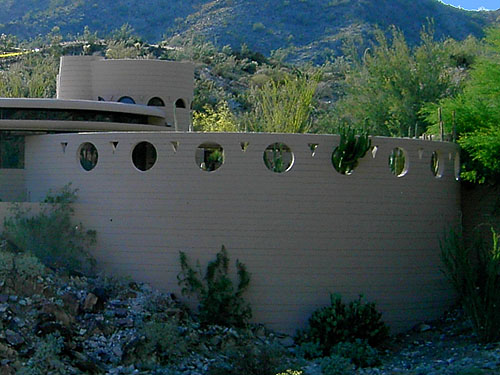 |
| 5C) Detail
of the Garden Court. (ST#2004.69.0615-5C) |
| |
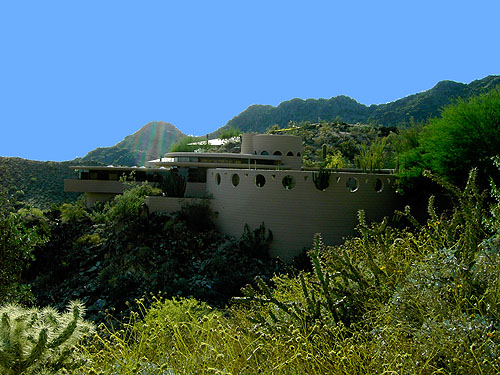 |
| 6) Lykes
Residence viewed from the Northeast. The Master Bedroom and
the Bedroom Wing is on the left. The Living Room is in the
center, the
Garden Court on the right. Clerestory windows cast
indirect lighting into the Living Room. The circular
Workspace (kitchen) can be seen in the background. A
circular staircase leads to an office above the Workspace.
Half circular windows pierce the walls of the office. The
built-in planter follows the curvature of the bedroom wing. (ST#2004.69.0615-6) |
| |
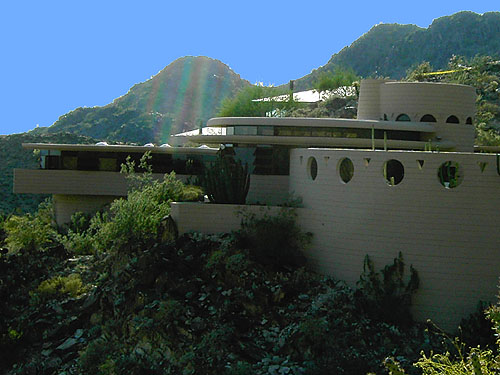 |
| 6A)
Detail. The Master Bedroom and
the Bedroom Wing is on the left. The Living Room is in the
center, the
Garden Court on the right. Clerestory windows cast
indirect lighting into the Living Room. The circular
Workspace (kitchen) can be seen in the background. A
circular staircase leads to an office above the Workspace.
Half circular windows pierce the walls of the office. The
built-in planter follows the curvature of the bedroom wing. (ST#2004.69.0615-6A) |
| |
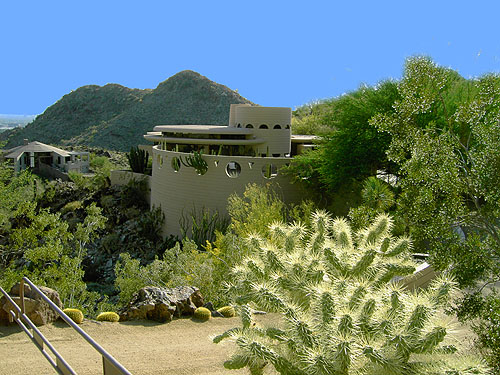 |
| 7) Lykes
Residence viewed from the Northeast. The Living Room can be
seen past the Garden Court which is visible in the
foreground. Clerestory windows cast
indirect lighting into the Living Room. The circular
Workspace (kitchen) can be seen in the center. A circular
staircase leads to an office above the Workspace. Half
circular windows pierce the walls of the office. (ST#2004.69.0615-7) |
| |
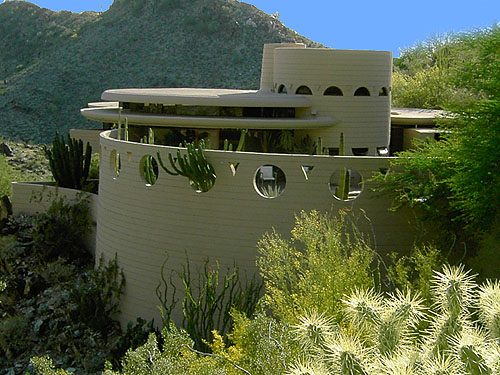 |
| 7A)
Detail. The Living Room can be seen past the Garden Court
which is visible in the foreground. Clerestory windows cast
indirect lighting into the Living Room. The circular
Workspace (kitchen) can be seen in the center. A circular
staircase leads to an office above the Workspace. Half
circular windows pierce the walls of the office. The
built-in planter, seen on the far left, follows the
curvature of the bedroom wing. (ST#2004.69.0615-7A) |
| |
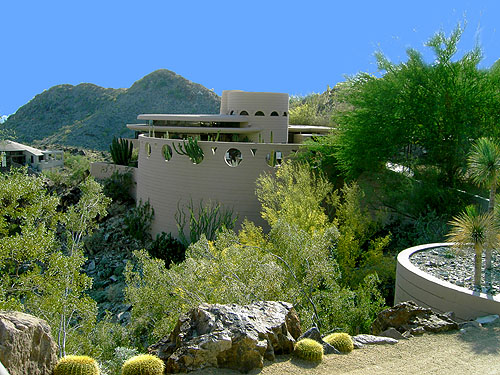 |
| 8) Lykes
Residence viewed from the Northeast. The Living Room can be
seen past the Garden Court which is visible in the
foreground. Clerestory windows cast
indirect lighting into the Living Room. The circular
Workspace (kitchen) can be seen in the center. A circular
staircase leads to an office above the Workspace. Half
circular windows pierce the walls of the office. (ST#2004.69.0615-8) |
| |
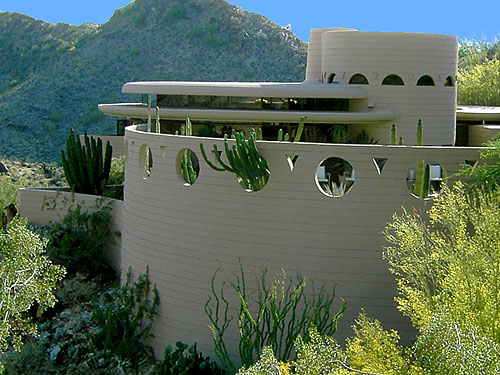 |
| 8A) Lykes
Residence viewed from the Northeast. The Living Room can be
seen past the Garden Court which is visible in the
foreground. Clerestory windows cast
indirect lighting into the Living Room. The circular
Workspace (kitchen) can be seen in the center. A circular
staircase leads to an office above the Workspace. Half
circular windows pierce the walls of the office. The
built-in planter, seen on the far left, follows the
curvature of the bedroom wing. (ST#2004.69.0615-8A) |
| |
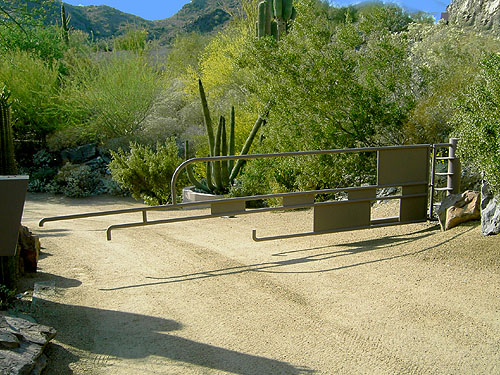 |
| 9) The
Entrance Gate. (ST#2004.69.0615-9) |
| |
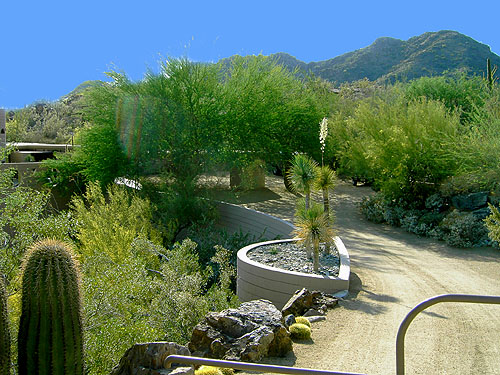 |
| 10)
Circular built-in planters adorn the circular driveway. (ST#2004.69.0615-10) |
| |
| |
| |
| |
|
|
|
Aime and Norman Lykes Residence, 2014 (1959 - S.433). Set of
eighteen images of the exterior Lykes Residence photographed
on April 17, 2014. Designed by Frank Lloyd Wright in 1959,
it was to be his last residential work. Working drawings
were completed in 1966 by Taliesin Fellow, John Rattenbury,
who had worked closely with Mr. Wright on the initial plans.
Rattenbury also supervised the construction of the home.
Based on intersecting and overlapping circles, the home is
over 2800 square feet. The circular design is constructed of
desert-rose tinted concrete blocks. The home is dramatically
built into the hillside, overlooking Phoenix and the valley.
As we approach the home it is viewed from below and reached
by a steep hill on the East side of the property. During |
|
this trip to Scottsdale, we had more time to photograph the
exterior this home than ten years earlier. The Master
Bedroom Balcony is cantilevered, and formed by two
intersecting circles. The built-in planter, although
separated from the bedroom wing by the living room, still
follows the curvature of the bedroom wing. Wright adapted
his designs to the landscape. Colors blend. He formed the
home around a major rock outcropping he wanted to preserve.
Stereotypical of Wright homes, it appears to "grow" from the
landscape. Built-in planters blend the natural landscaping
of the property with the home. Wright designed clerestory
windows to bring natural soft indirect light into the Living
Room. The roof above the clerestory windows appears to float
on glass. |
| |
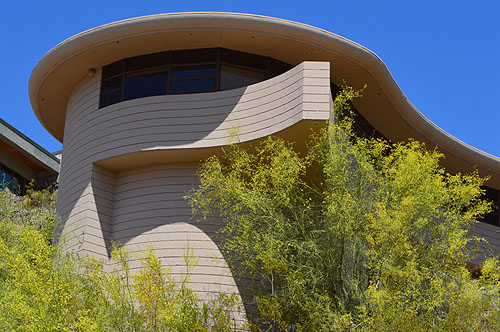 |
|
1) Lykes
Residence viewed from the South. The Bedroom wing's Master Bedroom
Balcony is cantilevered, formed by two intersecting circles.
Originally four additional Bedrooms were between the Master Bedroom and
the Living Room. In 1993, rooms were combined to reduce the
number of bedrooms from five to three. The Living Room is to the
right, out of the picture. (ST#2014.25.0715-1) |
|
|
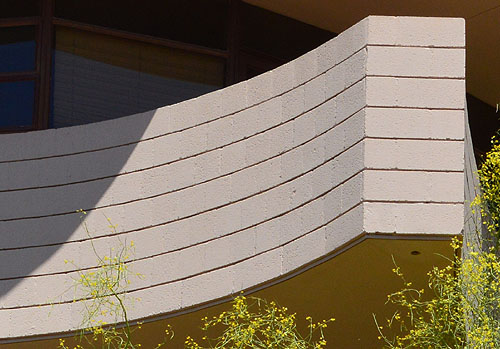 |
| 1A) Detail
of the Master Bedroom
Balcony. It is cantilevered, formed by two intersecting
circles. (ST#2014.25.0715-1A) |
|
|
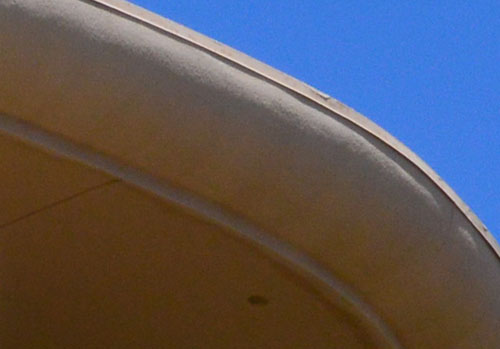 |
| 1B) Detail
of the roof fascia. Circular in form, it is consistent with
the rest of the design. (ST#2014.25.0715-1B) |
|
|
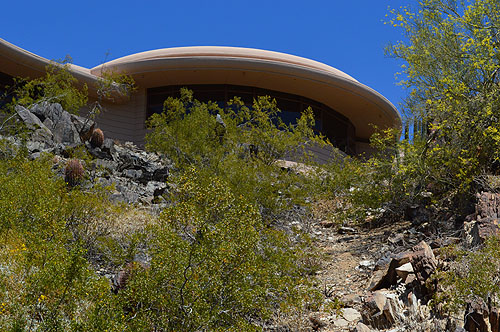 |
| 2) Lykes
Residence viewed from the South. The Living Room is
circular, the Bedroom wing is to the left.
Originally four, there are now two additional Bedrooms are
between the Master Bedroom and the Living Room. The Garden
Patio is to the right, out of the picture. (ST#2014.25.0715-2) |
|
|
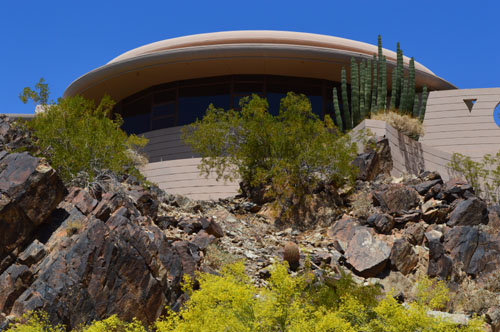 |
| 3) Lykes
Residence viewed from the South. The Living Room is
circular, the Bedroom wing is to the left, out of the
picture. The Garden Patio wall can be seen on the right. (ST#2014.25.0715-3) |
|
|
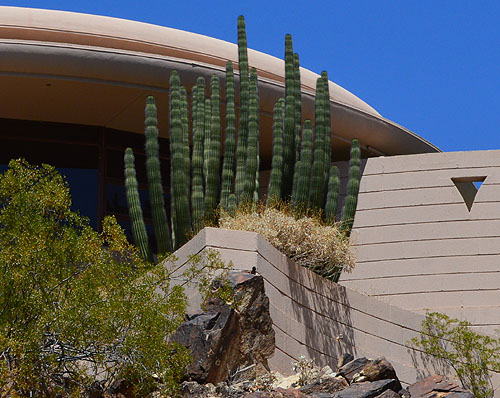 |
| 3A) Detail
of the built-in planter which follows the curvature of the
bedroom wing. Like the Master Bedroom balcony, it is formed
by two intersecting circles. (ST#2014.25.0715-3A) |
|
|
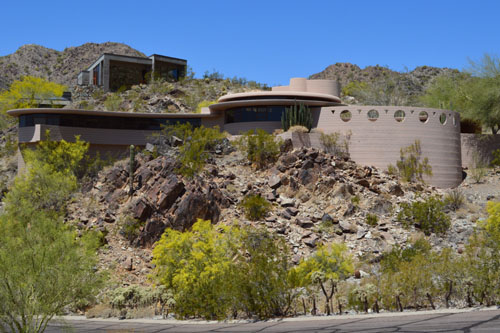 |
| 4) Lykes
Residence viewed from the Southeast. The Bedroom wing is on
the left. The Master Bedroom is on the far left, two
additional Bedrooms are between the Master Bedroom and the
Living Room. The Living Room is in the center. Clerestory
windows cast indirect lighting into the Living Room. Frank
Lloyd Wright formed the home around the rock outcropping he
wanted to preserve. The Garden Court on the right. (ST#2014.25.0715-4) |
|
|
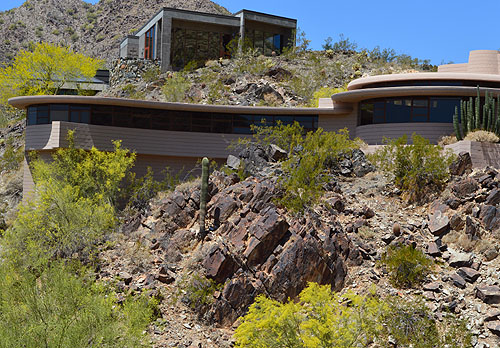 |
| 5) Lykes
Residence viewed from the Southeast. The Bedroom wing is on
the left, the Living Room is on the right. Clerestory
windows cast indirect lighting into the Living Room. (ST#2014.25.0715-5) |
|
|
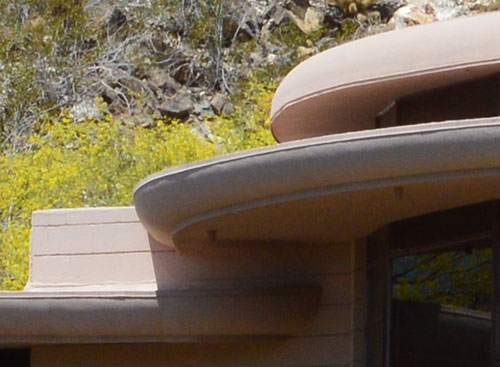 |
| 5A) Detail
of the Living Room Clerestory windows. (ST#2014.25.0715-5A) |
|
|
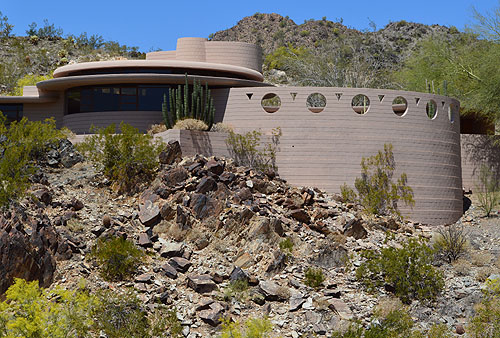 |
| 6) Lykes
Residence viewed from the Southeast. The Living Room is on
the left, the Garden Court is on the right. Cut out of the
Garden Court wall are repeating circles, and small triangles
formed by segments of an outer concentric circle. The
kitchen Workspace can be seen in the background above the
Living Room. (ST#2014.25.0715-6) |
|
|
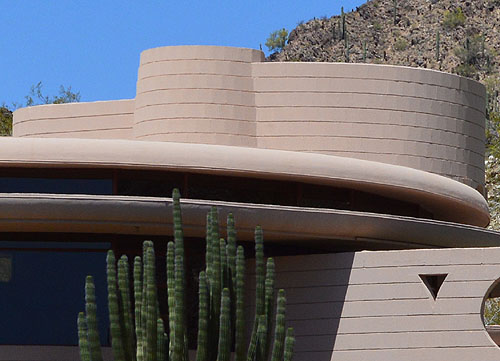 |
| 6A) Detail
of the upper level of the kitchen Workspace. The spiral
staircase on the left, leads down to the workshop under the
Living Room, which was converted to a home theater in 1993.
The fireplace chimney is in the center, an Office is on the
right, located above the kitchen Workspace. (ST#2014.25.0715-6A) |
|
|
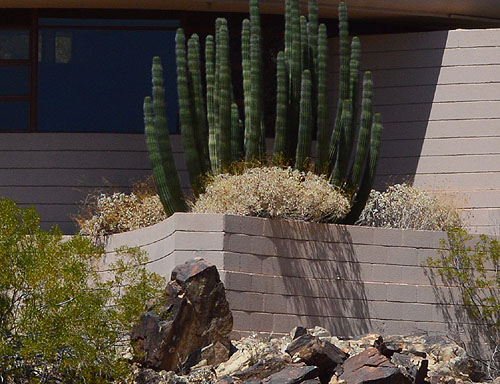 |
| 6B) Detail
of the built-in planter which follows the curvature of the
bedroom wing. Like the Master Bedroom balcony, it is formed
by two intersecting circles. (ST#2014.25.0715-6B) |
|
|
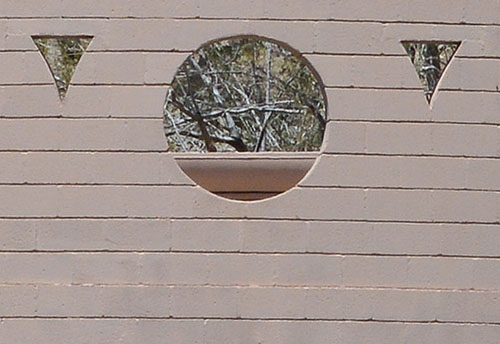 |
| 6C) Detail
of the wall. Cut out of the Garden Court wall are repeating
circles, and small triangles formed by segments of an outer
concentric circle. (ST#2014.25.0715-6C) |
|
|
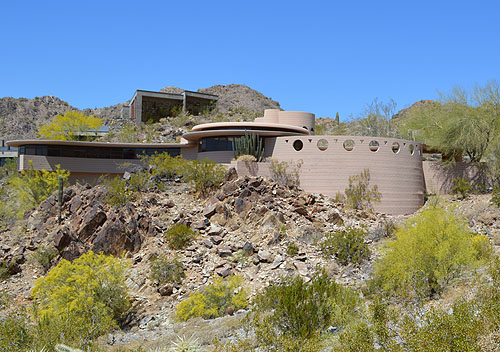 |
| 7) Lykes
Residence viewed from the Southeast. The Bedroom wing is on
the left. The Master Bedroom is on the far left, two
additional Bedrooms are between the Master Bedroom and the
Living Room. The Living Room is in the center. Clerestory
windows cast indirect lighting into the Living Room. Frank
Lloyd Wright formed the home around the rock outcropping he
wanted to preserve. The Garden Court on the right. (ST#2014.25.0715-7) |
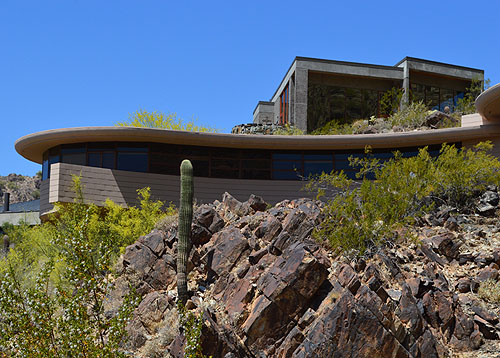 |
| 8) Lykes
Residence viewed from the East. The Master Bedroom is on the
left, two additional Bedrooms make up the Bedroom Wing. The
Living Room is on the right. (ST#2014.25.0715-8) |
|
|
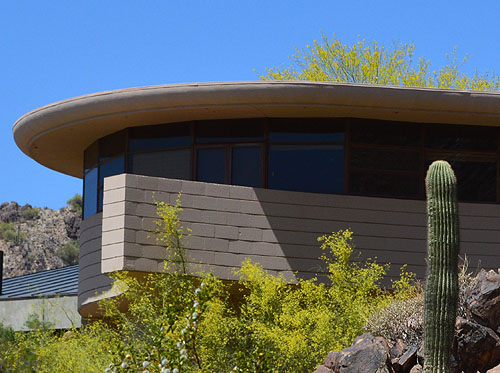 |
| 8A) Detail
of the Master Bedroom. (ST#2014.25.0715-8A) |
|
|
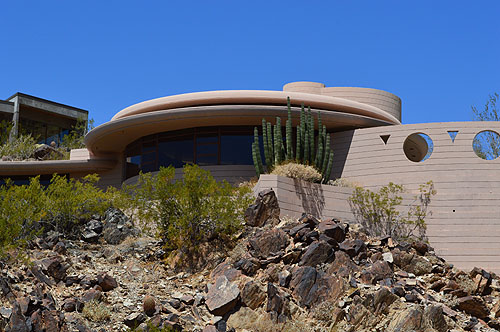 |
| 9) Lykes
Residence viewed from the East. The Bedroom Wing is on the
left, the Living Room is in the center, the Garden Court is
on the right. (ST#2014.25.0715-9) |
|
|
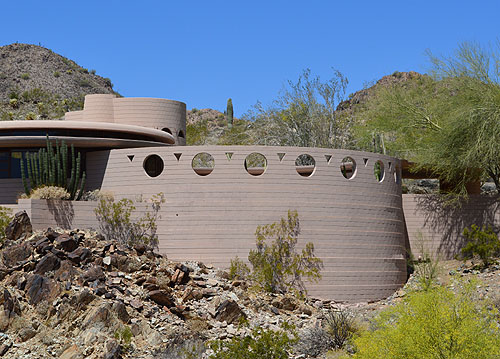 |
| 10) Lykes
Residence viewed from the East. Cut out of the Garden Court
wall are repeating circles, and small triangles formed by
segments of an outer concentric circle. The kitchen
Workspace can be seen in the background above the Living
Room which is on the left. The carport can be seen on the
far right. (ST#2014.25.0715-10) |
|
|
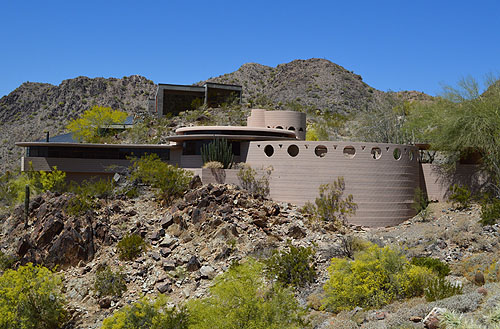 |
| 11) Lykes
Residence viewed from the East. This image shows how well
Frank Lloyd Wright adapted his designs to the landscape.
Colors blend. Stereotypical of Wright homes, they appear to
"grow" from the landscape. Wright formed the home around the
rock outcropping he wanted to preserve.
(ST#2014.25.0715-11) |
|
|
 |
| 11A)
Built-in planters blend the natural landscaping of the
property with the home. Wright designed clerestory windows
to bring natural soft indirect light into the Living Room.
(ST#2014.25.0715-11A) |
|
|
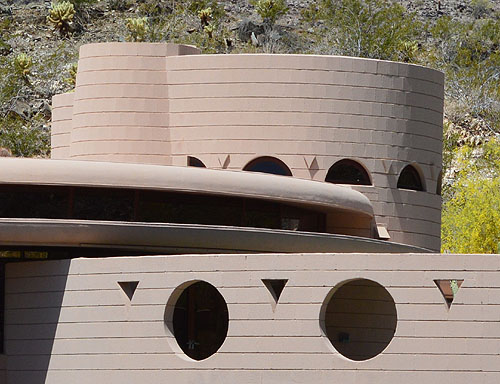 |
| 11B)
Circles flow, overlap and intersect each other. Cut out of
the Garden Court wall are repeating circles, and small
triangles formed by segments of an outer concentric circle.
The triangle shapes are repeated between the upper windows
of the office. But instead of cutting the shapes into the
wall, they stick out, casting soft shadows on the surface of
the wall. (ST#2014.25.0715-11B) |
|
|
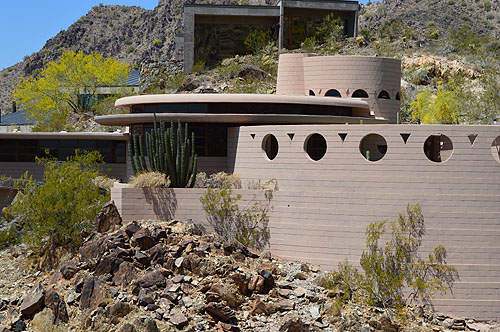 |
| 12) Lykes
Residence viewed from the East. The roof above the
clerestory windows appears to float on glass.
(ST#2014.25.0715-12) |
| |
 |
| 13) Lykes
Residence viewed from the East. The master Bedroom on the
far left appears to float above the landscape, just as the
Living Room roof seems to float above the Living Room
(ST#2014.25.0715-13) |
| |
 |
| 14) Lykes
Residence viewed from the East. The eye flows from one
section to the next, effortlessly, then back again to start
all over. (ST#2014.25.0715-14) |
| |
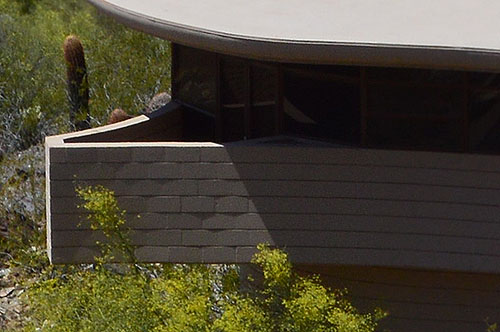 |
| 14A) The
Master Bedroom Balcony is cantilevered, formed by two
intersecting circles. Mortar in the horizontal joints are
racked, vertical joints are flush with the face.
(ST#2014.25.0715-14A) |
| |
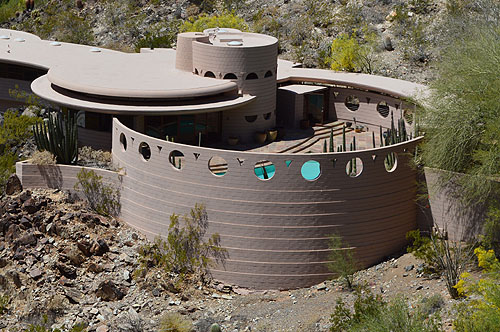 |
| 14B) The
walls of the Fireplace and the Garden Court lean inward as
they move upward. (ST#2014.25.0715-14C) |
| |
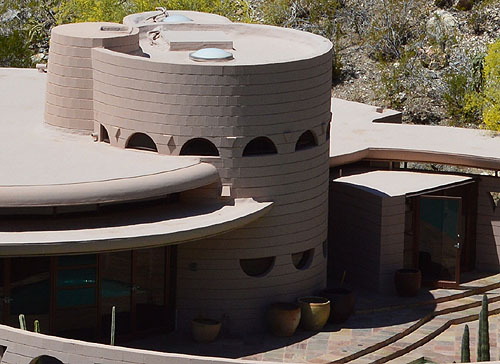 |
| 14C) Ten
rows of block intersect the circular windows creating two
halves. The lower half light the workspace, the upper half
light the office. The Garden Court is reached from the
Living Room on the left, the Entry hall on the right.
(ST#2014.25.0715-14C) |
| |
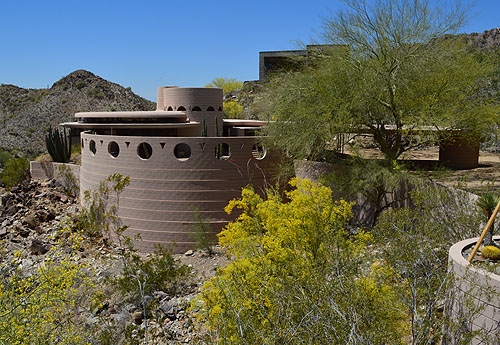 |
| 15) Lykes
Residence viewed from the Northeast. The Living Room is seen
in the background on the left, the carport on the far right.
The Garden Court is in the foreground, the Workspace in the
center background. (ST#2014.25.0715-15) |
| |
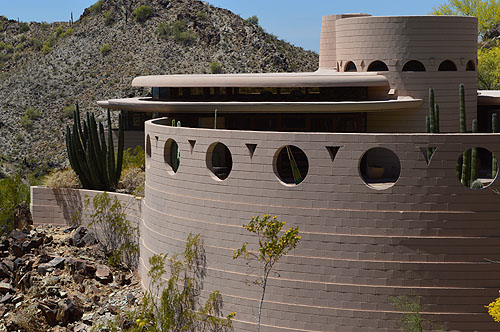 |
| 16) Lykes
Residence viewed from the Northeast. The Living Room is seen
in the background on the left, the Workspace is on the
right. The Garden Court is in the foreground.
(ST#2014.25.0715-16) |
| |
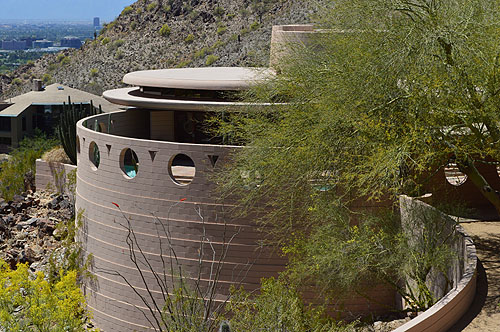 |
| 17) Lykes
Residence viewed from the Northeast. As the Garden Court
rises from the ground, every third row of blocks continues
to reduce in size. The built-in planter on the left follows
the same pattern as the Garden Court wall.
(ST#2014.25.0715-17) |
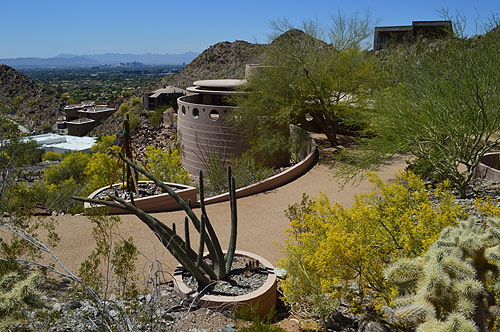 |
| 18) Lykes
Residence viewed from the Northeast. Built-in planters
border the drive. Phoenix and the valley can be seen in the
background. (ST#2014.25.0715-18) |
| |
| |
| |
| |
 |
| 1) Detail
of the Lykes Residence Dining Room table and chairs.
According to John Rattenbury, a few days before his death,
Wright sketched out the plans for the home, set them aside,
but never was able to returned to them, due to his death.
Rattenbury completed the working drawings and specifications
in 1966. Construction took place on the home for the next
two years. Rattenbury designed the furniture and built-ins,
adapted from the original plans created by Wright before his
death. Photographed by William Storrer, circa 1968. Courtesy
of the Oak Park Public Library. |
| |
 |
| 2) Detail of
the round Lykes Residence Dining Room table. |
| |
 |
|
3)
Detail of the Lykes Residence hassock and coffee table.
|
| |
| |
| |
|
|
|
|
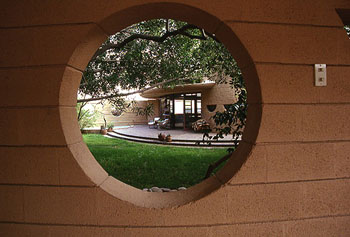 |
Date: Circa 1968
Title:
Aime and Norman Lykes Residence Garden Court and Terrace, Circa
1968 (1959 - S.433).
Description:
Lykes Residence Garden Court and Terrace viewed from the North
from the exterior side of the Garden Court wall. The fountain is
on the left, the Living Room is in the center, the Workspace is
on the right. The Terrace is in the foreground. Photographed by
William Storrer. Courtesy of the Oak Park Public Library.
See our Wright Study on the Lykes Residence.
Size:
10 x 6.75 Color photograph.
S#: 1757.15.0715 |
|
|
|
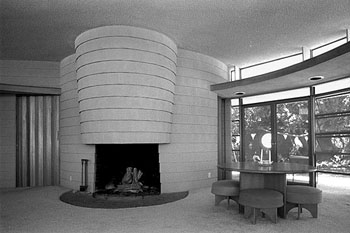 |
Date: Circa 1968
Title:
Aime and Norman Lykes Residence Living Room, Circa 1968 (1959 -
S.433).
Description:
Lykes Residence Living Room viewed from the South. John
Rattenbury worked with Wright on the initial plans for the home.
According to Rattenbury, a few days before his death, Wright
sketched out the plans for the home, set them aside, but never
was able to returned to them, due to his death. Rattenbury
completed the working drawings and specifications in 1966.
Construction took place on the home for the next two years. He
designed the furniture and built-ins, adapted from the original
plans created by Wright before his death. The bi-fold doors on
the left leads to the workspace which is located behind the
fireplace. The doors on the right leads to the Garden Court. The
table and hassock/chairs are on the right. Appears to be taken
before curtains were installed in the Living Room, visible in
the 1970 image. Photographed by William Storrer. Courtesy of the
Oak Park Public Library. See our Wright
Study on the Lykes Residence.
Size:
10 x 6.75 B&W photograph.
S#: 1757.16.0715 |
|
|
|
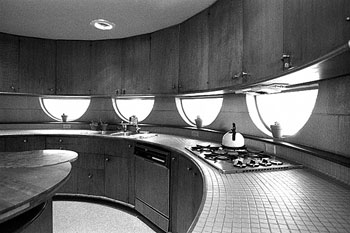 |
Date: Circa 1968
Title:
Aime and Norman Lykes Residence Workspace (Kitchen), Circa 1968
(1959 - S.433).
Description:
Lykes Residence Workspace. John Rattenbury worked with Wright on
the initial plans for the home. According to Rattenbury, a few
days before his death, Wright sketched out the plans for the
home, set them aside, but never was able to returned to them,
due to his death. Rattenbury completed the working drawings and
specifications in 1966. Construction took place on the home for
the next two years. He designed the built-ins, adapted from the
original plans created by Wright before his death. Cabinets are
constructed of Philippine mahogany. Photographed by William
Storrer. Courtesy of the Oak Park Public Library.
See our Wright Study on the Lykes Residence.
Size:
10 x 6.75 B&W photograph.
S#: 1757.17.0715 |
|
|
|
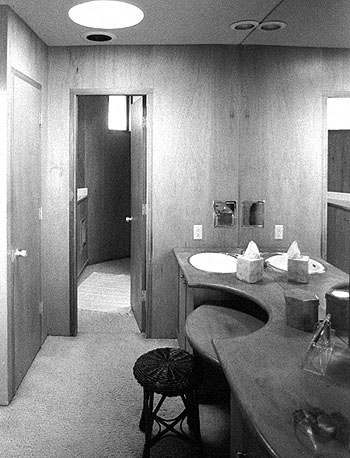 |
Date: Circa 1968
Title:
Aime and Norman Lykes Residence Master Bath, Circa 1968 (1959 -
S.433).
Description:
Lykes Residence Master Bath. John Rattenbury worked with Wright
on the initial plans for the home. According to Rattenbury, a
few days before his death, Wright sketched out the plans for the
home, set them aside, but never was able to returned to them,
due to his death. Rattenbury completed the working drawings and
specifications in 1966. Construction took place on the home for
the next two years. He designed the built-ins, adapted from the
original plans created by Wright before his death. Walls are
covered with, and the cabinets are constructed of, Philippine
mahogany. Photographed by William Storrer. Courtesy of the Oak
Park Public Library. See our Wright Study
on the Lykes Residence.
Size:
10 x 6.75 B&W photograph.
S#: 1757.18.0715 |
|
|
|
 |
Date:
1970
Title:
Phoenix - July
1970
Author: Anonymous
Description:
Frank Lloyd
Wright’s Circular Sun
House. Lykes House. (Sweeney
1828)
See our Wright Study
on the Lykes Residence.
Size:
Pages: Pp 5 54-56
S#: 1828.00.0404 |
|
|
|
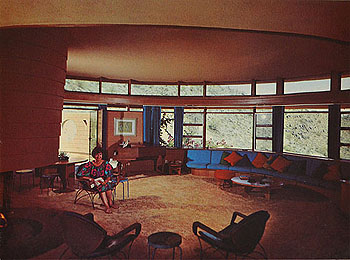 |
Date: 1970
Title:
Aime and Norman Lykes Residence Living Room, 1970 (1959 -
S.433).
Description:
Lykes Residence Living Room viewed from the study. The fireplace
is on the far left. The exit to the Garden Court is on the left
behind Aime Lykes. Built-in seating under the windows are on the
right. John Rattenbury worked with Wright on the initial plans
for the home. According to Rattenbury, a few days before his
death, Wright sketched out the plans for the home, set them
aside, but never was able to returned to them, due to his death.
Rattenbury completed the working drawings and specifications in
1966. He designed the furniture and built-ins, adapted from the
original plans created by Wright before his death. The round
Dining Room table is on the left. A small round end table is in
the center. A hassock and coffee table is on the right.
Photographed by Neil Koppes. Published in "Phoenix", July 1970,
p.55. See our Wright Study
on the Lykes Residence.
Size:
10 x 7.5 Color photograph.
S#: 1846.27.0715 |
|
|
|
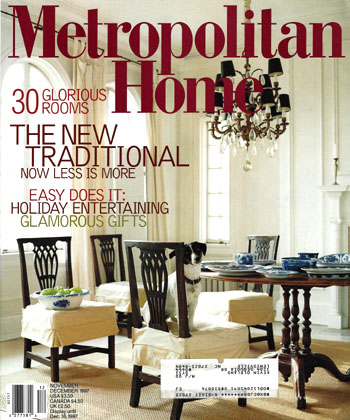 |
Date:
1997
Title:
Metropolitan Home - November/ December 1997 (Published by
Metropolitan Home, New York)
Author: Bernstein, Fred A.
Description:
The renovation of the Lykes Residence, Phoenix. "Renovating
Frank Lloyd (W)right. It Took More than Slavish Historicism to
Update a Phoenix Masterpiece. When Linda Melton bought this
Frank Lloyd Wright
house, its floors were covered in chartreuse shag: its woodwork
was speckled with cigarette burns; its exterior was a shade of
orange so unsubtle, ‘you could see it from the airport 12 miles
away.’ Three years later, it is an astonishingly skilled
composition, a homage in the key of Wright..." Includes 19
photographs by Tim Street-Porter, and one illustration. Original
cover price $3.50. See our Wright Study
on the Lykes Residence.
Size:
9 x 11
Pages: Pp 14, 168-177
ST#: 1997.66.0715 |
|
|
|
|
|
|
|
|
|
|

CLICK TO ORDER




































































